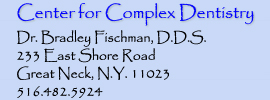 |
 |
Working with a Prosthodontist for Maxillary Surgery
Prior to obliterative surgery of the hard and soft tissues of the maxilla, it is important to prepare for the restoration of the defect. Obtaining records of the original shape of the maxilla and remaining dentition can reduce the difficulty in reestablishing the natural contours, which allow normal speech, swallowing, and esthetics. Even if a defect is not anticipated, it is wise to prepare for one. A simple impression will allow for the rapid construction of an unexpected obturator, with just a phone call from the O.R. If the surgery goes as expected there is always room in the circular file for the unneeded models.
Maxillary intraoral defects routinely require the construction of obturators. The placement of a transitional device, at the time of surgery, reduces both the psychological and physical problems associated with head and neck defects. Since most large defects are grafted, needing packing to keep the graft in position, an exact fit of the transitional obturator is not necessary to allow the patient to feel relatively normal, with little, if any, packing hanging down, and proper lip support, instead of a major esthetic and functional defect. The net result is a patient who is eating and drinking faster, and is less depressed. And, as we all know, a happy patient has less post operative problems.
With good preparation (and thanks to the DRGs) there is little need for the prosthodontist to see the patient in the O.R. or post operatively in the hospital. By the time the pack comes out, the patient is usually being dismissed. They can be sent directly to our office on the way home, or repacked and appointed the next day.
In a dentate patient, the tooth through which the cut is being made is critical. The posterior extent of the surgery is not as critical, it is easy to extend or shorten the device, changing the clasps that support the device via the teeth is a more major issue. If you are not sure of the cut, multiple options can be placed in the surgical obturator.
Referral for preliminary evaluation and record taking should be done as early in your treatment planning as possible. With just a rough idea of the location of the cuts, we can prepare the mouth for several options, and necessary records for construction of the surgical obturator can be obtained. Then, as surgery approaches, and you finalize your treatment plan, the device can be fabricated without having to rush it through the laboratory due to the limited time from patient presentation, in our office, to O.R. time. With adequate time, I will have the device in your hands a day or two prior to surgery. Following an adequate healing period and a chance for the defect to become stable, a new obturator will be constructed. If radiation or chemotherapy is to part of the patient’s therapy, timing may be altered. Once inserted, the final obturator will need continuing supervision, since the soft tissues surrounding it will change in time, and the plastic and metal will not.
We have restored many cases with the aid of dental implants, used to stabilize the prosthesis when teeth are not present. Even in cases involving 80% loss of the hard palate the results have been dramatic.
Patients appreciate coordinated treatment and consistent explanations. All the treatments from diagnosis to obliterative surgery, to radiation and chemotherapy and to rehabilitation are a team effort. The captain is the primary surgical specialist and oncologist.. Prosthetic rehabilitation is one area of the patient’s recovery and always related to other therapies. If there are changes in the diagnosis or planned therapy it is important that I am kept up to date so I can alter my treatment schedule to accommodate other therapy and give psychological support to the patient. Remember, during active therapy I am usually seeing the patient weekly.
Please remember that no matter how well constructed an obturator is, it never fully replaces the form and function of the mouth. For no other reason than an obturator is removable, it is different. if you don’t promise too much, the patient will only be pleasantly surprised.
Dentures | Extreme Makeovers | Doctor's Credentials | Map & Policies | Contact Us
Home | Professional Referrals | Tidbits for Dentists | Newsletters for MDs